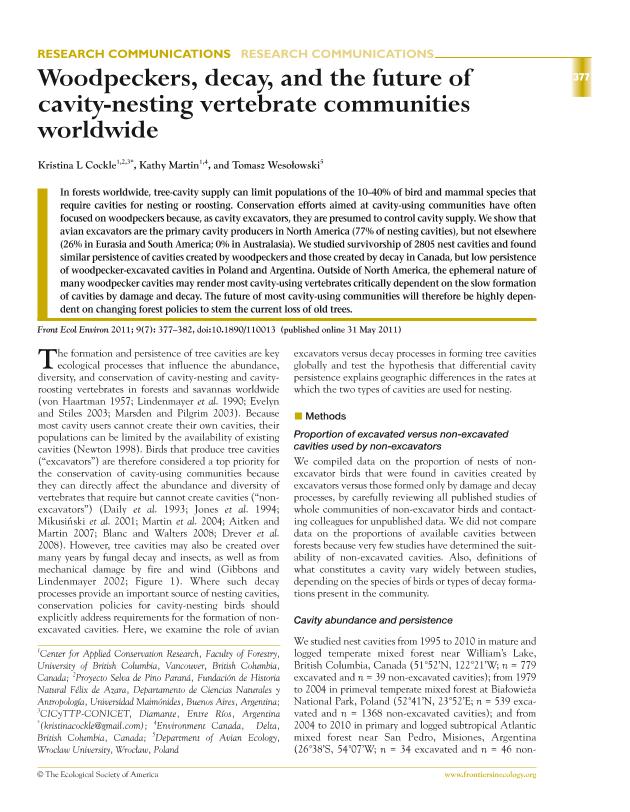Mostrar el registro sencillo del ítem
dc.contributor.author
Cockle, Kristina Louise

dc.contributor.author
Martin, Kathy
dc.contributor.author
Wesołowski, Tomasz
dc.date.available
2019-07-25T18:53:21Z
dc.date.issued
2011-09
dc.identifier.citation
Cockle, Kristina Louise; Martin, Kathy; Wesołowski, Tomasz; Woodpeckers, decay, and the future of cavity-nesting vertebrate communities worldwide; Ecological Society of America; Frontiers in Ecology and the Environment; 9; 7; 9-2011; 377-382
dc.identifier.issn
1540-9295
dc.identifier.uri
http://hdl.handle.net/11336/80301
dc.description.abstract
In forests worldwide, tree-cavity supply can limit populations of the 10-40% of bird and mammal species that require cavities for nesting or roosting. Conservation efforts aimed at cavity-using communities have often focused on woodpeckers because, as cavity excavators, they are presumed to control cavity supply. We show that avian excavators are the primary cavity producers in North America (77% of nesting cavities), but not elsewhere (26% in Eurasia and South America; 0% in Australasia). We studied survivorship of 2805 nest cavities and found similar persistence of cavities created by woodpeckers and those created by decay in Canada, but low persistence of woodpecker-excavated cavities in Poland and Argentina. Outside of North America, the ephemeral nature of many woodpecker cavities may render most cavity-using vertebrates critically dependent on the slow formation of cavities by damage and decay. The future of most cavity-using communities will therefore be highly dependent on changing forest policies to stem the current loss of old trees.
dc.format
application/pdf
dc.language.iso
eng
dc.publisher
Ecological Society of America

dc.rights
info:eu-repo/semantics/openAccess
dc.rights.uri
https://creativecommons.org/licenses/by-nc-sa/2.5/ar/
dc.subject
Decay
dc.subject
Tree Cavities
dc.subject
Woodpeckers
dc.subject.classification
Ecología

dc.subject.classification
Ciencias Biológicas

dc.subject.classification
CIENCIAS NATURALES Y EXACTAS

dc.title
Woodpeckers, decay, and the future of cavity-nesting vertebrate communities worldwide
dc.type
info:eu-repo/semantics/article
dc.type
info:ar-repo/semantics/artículo
dc.type
info:eu-repo/semantics/publishedVersion
dc.date.updated
2019-07-23T12:58:45Z
dc.journal.volume
9
dc.journal.number
7
dc.journal.pagination
377-382
dc.journal.pais
Estados Unidos

dc.journal.ciudad
Washington
dc.description.fil
Fil: Cockle, Kristina Louise. University of British Columbia; Canadá. Universidad Maimónides; Argentina. Provincia de Entre Ríos. Centro de Investigaciones Científicas y Transferencia de Tecnología a la Producción. Universidad Autónoma de Entre Ríos. Centro de Investigaciones Científicas y Transferencia de Tecnología a la Producción. Consejo Nacional de Investigaciones Científicas y Técnicas. Centro Científico Tecnológico Conicet - Santa Fe. Centro de Investigaciones Científicas y Transferencia de Tecnología a la Producción; Argentina
dc.description.fil
Fil: Martin, Kathy. University of British Columbia; Canadá. Environment Canada; Canadá
dc.description.fil
Fil: Wesołowski, Tomasz. Wrocław University; Polonia
dc.journal.title
Frontiers in Ecology and the Environment

dc.relation.alternativeid
info:eu-repo/semantics/altIdentifier/url/https://esajournals.onlinelibrary.wiley.com/doi/abs/10.1890/110013
dc.relation.alternativeid
info:eu-repo/semantics/altIdentifier/doi/https://doi.org/10.1890/110013
Archivos asociados
